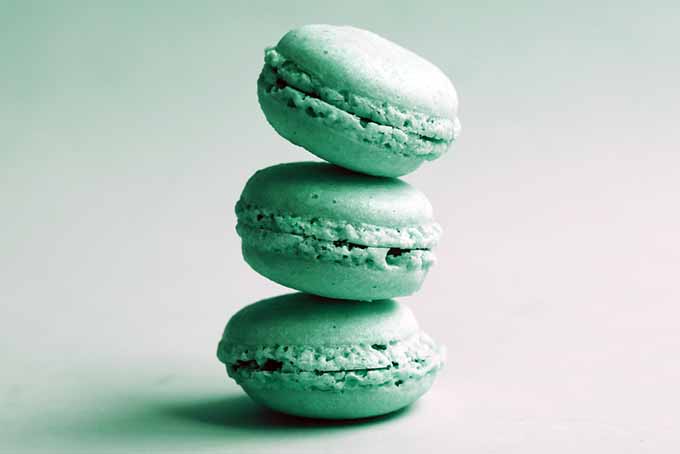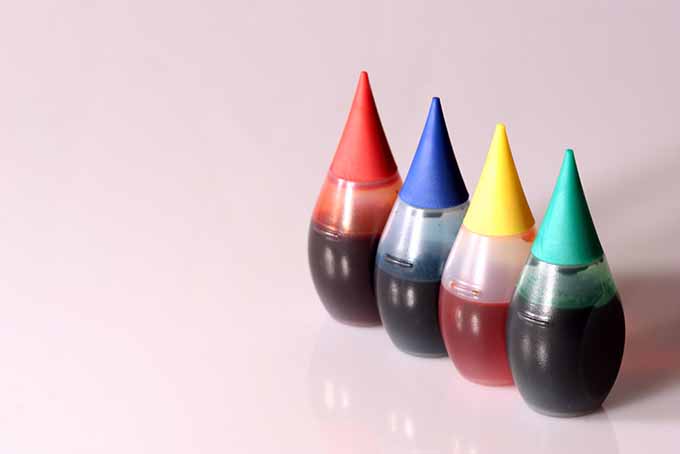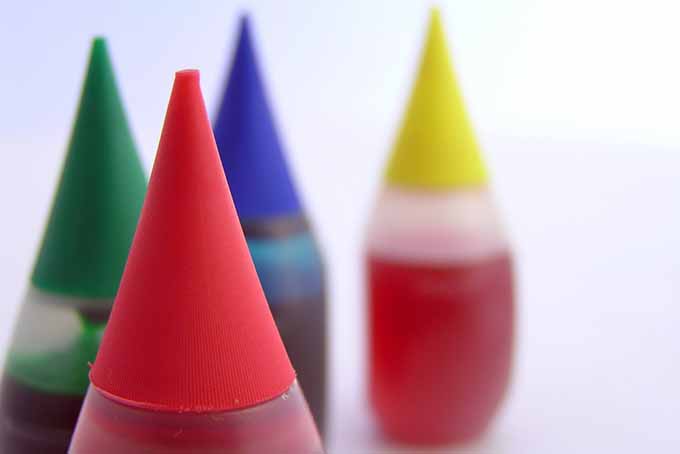A common food additive, food dyes are often used to give a more appealing and desirable appearance. If you ever read food labels, you’ve probably seen them listed after the term “FD&C” as a color followed by a number, such as Blue 1, or Red 40.

But what’s not revealed on the label? The many health-related side effects that may come as the result of consuming artificial food colors.
Found in many forms – including liquids, gels, pastes, and powders – color additives are also found in medicines, cosmetics, and even medical devices, though this article will only discuss the food applications.
Why Are Food Dyes Used in Processed Goods?
Interestingly, food pigments actually help to influence your taste buds via a neurological experience.
Simply put, when you see a beverage that’s colored blue, it may automatically evoke a blueberry or blue raspberry flavor, even if it is not flavored as such.
It’s also widely known that colors like yellow and red visually increase appetite, especially when juxtaposed (take the chosen colors of the McDonald’s logo for example).
Ripe fruits are nutrient dense as well as flavorful, and colored vibrantly. Color also helps you to instinctively perceive the nutritional value and quality of an item when it comes to your plate.

This experience is an evolutionary marvel, related to how your ancestors would have known which natural foods would be the most beneficial to consume.
A small portion of the population even have a fascinating condition called synesthesia, which occurs when one sense stimulates another – and can change one’s perception about food and drink to the point of smelling textures or even tasting colors.
Food dyes correct color that may be lost in food storage, but may also be added to enhance appetite visually – so even if your food sat on a shelf for an extended amount of time, it will still appear appetizing with the addition of food dyes.
They Make Food Dyes Out of What?
Artificial food colorings are made from petroleum-derived chemicals. That doesn’t sound so bad, until you consider that gasoline, tar, asphalt, diesel fuel, and other products you would never consider consuming are made from petroleum also.
Antifreeze may be added to the chemical cocktail to help retain color. Additionally, 10 percent or more of a batch of food dye may be comprised of impurities that occur in the manufacturing process itself, or from the chemicals used.

While there are some natural sources used to color food, such as beets or beetles, chemical food dyes are more commonly used. (Yes, beetles, as in the bugs. Many products with red coloring contain carminic acid, made from crushed beetle shells.)
This is simply because they are cheaper to make and retain color longer, improving profit margins for food producers.
Added colors offer absolutely no nutritional value to foods, and only exist in food and drinks to trick your senses into conveying the perception that you are enjoying your food.
Health Effects of Food Dyes
There are several issues with consuming food color additives, as they may be neurotoxic (or damaging to nerve tissue), carcinogenic (cancer-causing), and genotoxic (damaging to chromosomes).
While most studies to date have not been conducted on humans, the amount of data collected regarding the effects of food dyes on lab animals cannot be ignored.
And furthermore, if food coloring is used to get kids to choose vibrantly colored processed foods, it could be said that they even contribute to the obesity epidemic.
In a Washington Post opinion piece, authors David W. Schab and Michael F. Jacobson stated, “Beyond the behavioral problems and cancer risks, the greatest hazard that dyes pose for children may also be the most obvious: They draw kids away from nutritious foods and toward brightly colored processed products that are high in calories but low in nutrients, such as fruit-flavored drinks and snack foods.”
There are nine food dyes used in the U.S., though one of them (Orange B) is rarely utilized. Three of these – Red #40, Yellow #5, and Yellow #6 – combine to account for 90 percent of the total amount used.
Here are the top eight:
Blue #1
Most often used in beverages, baked goods, and other sweetened products, Blue 1 (Brilliant Blue) has been found to cause kidney tumors in mice.
In 1999, reports began associating Blue #1 with adverse health effects, as it was determined that it could be absorbed by the digestive tract and then passed into the bloodstream.

Blue #2
Indigo Carmine, also known as Blue #2, is not only used in food and drinks, but is also added to prescription drugs and (surprise!) could be in your pet food, too. It has been shown to cause tumors in male rats, most often brain gliomas.
Citrus Red #2
Added to Florida oranges to improve appearance in under-ripened fruit, Citrus Red #2 has been shown to cause bladder tumors in rats, and it was classified as a Group 2B carcinogen due to its potential for being carcinogenic to humans as well. Additionally, it may affect organs other than the bladder.
Green #3
Used in beverages, candies, and frozen treats like ice cream, Fast Green has been associated with bladder and other cancers in male rats. It is not as commonly used as other food color additives.
Red #3
In 1990, the Food and Drug Administration (FDA) determined that Erythrosine, or Red #3, was a thyroid carcinogen and had it removed from cosmetics and topical drugs. However, it is still permitted in foods such as maraschino cherries. You might want to skip the cherry on top of your banana split next time.

Red #40
The most consumed food dye, Allura Red may cause an allergic reaction called hypersensitivity.
I spoke with Registered Dietitian and Licensed Nutritionist Lori Langer about hypersensitivity, and she had this to say: “If one has a sensitivity to a food dye, a chemical reaction is triggered, causing inflammation in nearly any part of the body. In response to ingestion, white blood cells are triggered to release mediators that in turn cause inflammation in surrounding tissues.
“This is manifested by any number of symptoms, such as asthma, eczema, urticaria, angioedema, perennial rhinitis, itching, migraines, and digestive disorders. I see symptoms brought on by sensitivity to food dyes often in my private practice. Once the diet is cleaned up, symptoms usually resolve.”
Recent studies associate Red #40 with hyperactivity in kids, and cancer of immune system components. It’s used in many baked goods, cereals, drinks, and candies, and accounted for 40 percent of food dye use in 2009.
Yellow #5
The second most widely used food coloring, Tartrazine is used in many of the same types of foods and produces similar effects as Allura Red, including hypersensitivity and hyperactivity in children. It may include “random contaminants,” the potential side effects of which are currently unknown.
Yellow #6
Sunset Yellow – found in cereals, gelatin desserts, and sausage – has caused adrenal and testicular tumors in animals. It is also associated with hypersensitivity, which may be more severe than reactions to other dyes.
Do you know how many of your favorite foods contain food coloring?
You might be surprised to learn that artificial coloring is added to many commonly consumed items, including cereal bars, cheese, mac and cheese, pickles, yogurt, and even kids’ vitamins.

While very small doses of artificial coloring may not be cause for concern, you’re probably consuming a whole lot more than you realize.
Banned Outside the U.S.
Many countries outside the United States recognize the dangers of artificial food coloring and have banned them from the food supply, including Austria, Finland, France, Norway, and the U.K.
According to the book Rich Food, Poor Food: The Ultimate Grocery Purchasing System by husband and wife team Jayson and Mira Calton, there are eight ingredients allowed in our food that don’t make the cut in other countries. Among the list? Arsenic, brominated vegetable oil, and of course, artificial food dyes.
Looking to learn more? Rich Food, Poor Food is available now on Amazon.
A story from ABC News reads, “The Food and Drug Administration assures the public that despite the frenzy over the list of ingredients banned in some countries outside the U.S., it is doing its job of monitoring food safety.” The FDA also mentions that they use an “extensive, science-based process to evaluate the safety of food additives.”
So how can the science be different between countries? According to St. Catherine University’s Julie Jones, professor emeritus, this “science” has just as much to do with politics as it does actual research in proving the safety of artificial ingredients.

Dietitian Lori Langer said, “I find it appalling that food dyes are not banned in the U.S. as they are in other countries. I suspect it is the lobbyists for food and chemical companies that prevent this from happening. However, as a result Americans are getting sicker and sicker, and doctors very rarely look at a patient’s food consumption as the culprit.”
Oftentimes, to be considered safe for human consumption, other countries assume ingredients are harmful until proven otherwise. Here in the U.S.? It typically works in the opposite manner, and food additives are often considered safe (or GRAS – Generally Recognized As Safe) until studies prove they are not.
Brands like Nestlé, Kraft, Kellogg’s, Coca Cola, and other large distributors that control the world’s food supply must produce their foods differently on other continents because of this. Isn’t it time we step up and demand the same food safety regulations as other nations?
Feel good about your food choices!
Some food companies are dedicated to selling products that free of potentially unsafe food additives, saying they will reduce the amount of potentially harmful artificial ingredients they use.
General Mills, Campbell’s Soup Company, and even Kraft and Nestlé are listening to their consumers, and plan to offer safer food choices to consumers. Some companies will eliminate artificial products altogether, while some are simply committed to using less of them.

When you’re on the run and don’t have time to cook at home, some fast food eateries and restaurants offer dye-free, delicious meals– Noodles & Company, Chipotle, Panera, and Taco Bell are among them.
Remember, according to author L. N. Smith, “Every dollar you spend, or don’t spend, is a vote you cast for the world you want.” Make your votes for food purity and safety count by supporting food companies that are trying to make your food healthier.
Looking for another fascinating food safety read? Check out our post on prepackaged lettuce mixes here.
Fun With Food Coloring
You don’t need to toss your food coloring in the trash just yet. Have a blast with them in other ways by coloring:
- Tie dye t-shirts
- Easter eggs
- Homemade play dough
- Brilliantly colored bubbles
- Funky glue
- Christmas tree ornaments
- DIY puffy paint
- Clay beads to put on a necklace or bracelet
- Lava for a science experiment
- Fun snowballs

Once the artificial stuff has run out, one of my favorite things about using food dyes for coloring Easter eggs or other projects with my kids is experimenting with our own natural food colorings.
We’ve used everything from onion peels to spinach to make natural hues, and it’s a great way for the kids to learn more about their food, and why we don’t consume artificial ingredients.
Many varieties of chicken eggs are naturally hued in a variety of shades from brown and red to blue and green. To learn more, check out this post.

Summer is a great time to head outdoors and try some fun projects with food coloring, because you can keep the mess out of the house.
The Bottom Line
If you do choose to consume products made with artificial dyes, try to opt for those foods that also offer vitamins, minerals, and other nutrients. Better safe than sorry, and I prefer to take the stance that something should be proven safe before consuming it. And, as I always recommend, limit your intake of processed foods for optimum health.
Have you researched food dyes and the effects on your health? Have you eliminated food dyes to help manage a health condition your child has, that is commonly associated with additives? Share your stories in the comments.
This post is not intended to diagnose, treat, or cure any ailments and should not be mistaken for medical advice. Before changing your diet, talk to your doctor or other medical health professional.
Photo Credits: Shutterstock. See our TOS for more details.
About Tiffany Boutwell
Tiffany Boutwell is a Certified Nutritional Consultant, Holistic Health Practitioner, and owner of Natural Apple Holistic Health. Tiffany believes chronic illness stems from improper nutrition, and that a diet rich in whole foods can help people to be free from the undesirable effects of the Standard American Diet. She resides on a farm in Kentucky with her family where she enjoys reading, yoga, and writing. Tiffany has authored an e-cookbook and health articles in various publications.






Wow, I never realised there were so many health hazards connected to food colouring/dyes. I am not a fan of them but never realised the dangers. This is a truly insightful post. Thank you. I also love the fact that you put a positive spin on this w.r.t. the many other ways to use coloring agents for “play”. I have two small children and I think I am going to try some of them, especially the play dough and bubbles…
This is a real eye opener for me. I never knew that food dyes could cause so many bad side effects. We often say that we eat with our eyes. So what would this mean for kids who go to the store and see rainbow colored cereals? It will not be enough to tell kids to be aware of food dyes. If we make foods just as appealing to them as colorful processed foods, this might help.
Wow, I had no idea that food dyes can be bad for our health, since it seems to be such a common ingredient in almost all foods, but at the end of the day they are still chemicals, and they are still artificial stuff, so of course that it would be dangerous.
On the other hand, I find really interesting the fact that we relate colors with flavors, and it actually made me think about a few times where I expected that something tastes in particular way, just because the color of it, and when it really didn’t I was pretty disappointed, lol.
What a fantastic article, Tiffany. It really did make me want to go into the spice cupboard and toss the colors I currently have in there. I guess maybe I will use them for some of the other options you offered instead.
Eek. I had no idea that this stuff was made from basically poison. Really good to know, so we can be more careful. I’ll be experimenting with the natural methods now.
This is a very serious issue all over the world. Although some countries have imposed a ban on the use of such harmful things in processed food and even in natural food, but most of the countries are yet to take preventive measures. It’s extremely harmful, especially for children who just love the taste and color. Authorities must have some kind of compulsion towards the makers because it’s a huge revenue earning industry. But we, as parents or guardians or even as socially responsible citizens should make others aware of the danger as lack of awareness is the reason why this has been going on. Thanks Tiffany for raising the issue. It can be fatal if not sorted out immediately.
What an interesting article! Although we know that artificial food isn’t a very nutritious option, I didn’t think that they could be this dangerous. I love to bake “rainbow cakes” with my little cousin, because the colors are very attractive, especially for the kids… The article was a real eye opener and I’ll be careful with the additives that I use in my kitchen. Also, it’s very important to be careful with the products of the big companies we consume and always read the info to know what we are eating. Thank you for sharing this article and explaining important questions about this issue.
This issue should be addressed more. Many people I know think food dyes are harmless when in reality it is. Yes it makes food look better altogether but eating or even drinking it isn’t good for our bodies. That’s why I’m trying to eat completely organic and natural foods each day because every food is a hazard, basically.
Thank you for sharing. I shudder as I see parents ignorantly buying baked food stuffs with a million and one food colors just because the child is crying for it. Why in the world would I give my child chemicals that in the long run will have an adverse effect on their health? The public needs to get educated because this is one serious problem I see over and over again. I will not let the adults off that easily, they should be more responsible.
I had a feeling that food dyes had to have some health concerns. I use food dye to make a swirled sugar cookies for different holidays and it always amazed me how it would stain my hands for days. Something that does that can’t be too great for your health can it? With all that said, I assume that casual consumption of food dyes isn’t a big deal. Let’s be honest, if you are eating processed foods enough that the food dye is a concern, you are already at risk for more sever health problems anyways.
Wow! This is one of the scariest food-related articles I’ve read in recent times. I’ve known that food coloring isn’t necessarily nutritious but I had no idea it was this bad. I’ll admit I’ve never actually researched the stuff before. Now I’m definitely going to be wary of overly colorful edibles. I’m particularly concerned that it’s being added in fruits. Vegetable dyes to make lip stains and other cosmetics is something that I’ve been trying to work on. Looks like I’ll be extending that to my cooking as well.
Thank you for writing this article. I constantly try to warn my friends and family about the dangers of food dye and heavily processed foods. I always hear the excuse, “If it wasn’t safe the government wouldn’t let them sell it.” I kindly remind them that the government only permits the sale of safe things like cigarettes and alcohol. They laugh, but it makes them think. More articles like this one may actually increase awareness and hopefully our government will see the light like most of the European Union has.
For the longesst time I’ve stayed way from food dyes simply because they look unhealthy and they’re made from chemicals. Despite my hardest efforts sometimes you have to eat them, they’re found in a lot of recipes and you can even get them in your mouth without knowing. I didn’t know the health risks depended on the color.
Well this certainly really raises the flag concerning my use of food dyes, but the good news is that I do not use them often so I am okay there. The problem still remains, though, of the additives that are in there before they get to my kitchen, because of course those are out of my control. I never knew the whole red and yellow colors increase appetite, and now that McDonald’s logo makes a little more sense. The hazards to our health are very worrisome, and I hope that we see something done about them fairly soon. Thanks for sharing.
Alas this is just one more reason to stay away from processed foods as far as possible, and altogether if you can. We are going to have to learn that the companies that make our food don’t have our health as their main priority – profits are their main priority and always will be – that’s just how business works. It’s up to us to inform and protect ourselves and our families by reading informative articles like this one! Food dyes are just one example from the long indecipherable ingredient lists which are used to trick us. Thank you Tiffany for this very important information.
Beetles?! WTF… I’ve been eating stuff with beetle shells all along… poor poor beetles…
That aside, this is a great well-researched article ^_^ I’m curious, however, on whether there’ll be adverse effects if food colors are mixed with one another (which is fairly normal). I’m also curious as to why they have those side effects, although I guess that would be too scientific already.
On the other hand, this issue should totally be researched upon more as food dyes are already widely used. But then again, it doesn’t make much sense to be overly reacting to it.
Thanks for sharing this eye-opening article. I am ashamed to admit that this is just one of those things that I never thought about before now. And now that I’m a mother, I need to really start taking note of what I’m letting my little girl consume. I will certainly start to pay more attention to food labels from now on.
I really look at the claims of dyes causing cancer with a skeptical eye. First, these tests are usually carried out on male rats, who are not only more prone to tumors than humans, but who are exposed to extremely large, concentrated amounts of the dye over a fairly short period of time. It would be extremely difficult for a human to consume an equivalent amount, and they would probably be quite sick from other causes, such as overeating or malnutrition, first. However, the idea of using bright colors to attract children (and adults) toward unhealthy, brightly colored food as opposed to colorful fruit and vegetables is a fair point. Sometimes even fruit and vegetables are treated with dyes or colored wax to make them look brighter or to cover up blemishes.
People need to wake up! The GMO in our food thanks to Monsanto is like eating Roundup Weed Killer in our grains! Along with artificial coloring it’s causing many health issues!